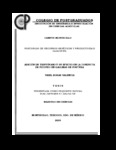| dc.description.abstract | El picoteo en aves es un problema que se presenta con frecuencia en las granjas avícolas, pudiendo causar la muerte de las mismas. El despicado de las aves es una práctica común para evitarlo pero que causa estrés en los animales, reduciéndose el consumo y afectándose su productividad. Una alternativa para disminuir el picoteo y evitar el despicado es suplementar triptófano en la dieta por arriba del requerimiento establecido. El objetivo de este trabajo fue determinar si disminuye la frecuencia de picoteo en gallinas de la línea Bovans, en etapa de postura, cuando se agrega triptófano a la dieta por arriba del requerimiento, así como evaluar algunas variables productivas. Se evaluaron los siguientes tratamientos: (T1 sin despicar, T2 despicado; con 1.6 g de triptófano kg-1 alimento); (T3 sin despicar, T4 despicado; con 2.6 g de triptófano kg-1 alimento) y (T5 sin despicar, T6 despicado; con 3.6 g de triptófano kg-1 alimento). Las aves se distribuyeron al azar, para cada tratamiento se tuvieron 18 jaulas con dos aves en cada una. Se uso un diseño completamente al azar con arreglo factorial 3 X 2, el factor A (1.6, 2.6, 3.6 g de triptófano kg-1 de alimento) y el factor B (sin despicar, despicado). El análisis de los datos se realizó por análisis de varianza y la comparación de medias por la prueba de Tukey. Las variables productivas producción de huevo, peso del huevo, masa de huevo, consumo de alimento y conversión alimenticia, no presentaron diferencias (P≥0.05). En las variables de conducta (acicalamiento, alimentación, descanso y locomoción), los animales suplementados con 3.6 g de triptófano kg-1 alimento, dedicaron menor proporción de tiempo a alimentarse. En el picoteo de pluma se encontraron diferencias (P≤0.002) en el primer periodo presentando una menor frecuencia de picoteo en el tratamiento con 3.6 g de triptófano kg-1 alimento, dentro del segundo período se encontraron diferencias (P≤0.006) al presentar un menor intento de picoteo las aves que no fueron despicadas. Se encontró una correlación positiva entre la conducta de las aves y la temperatura ambiental, debido a que al aumentar esta se modifica la actividad motora de las aves. Por otra parte, se encontró una correlación positiva en las variables productivas, ya que éstas mejoran bajo condiciones favorables de temperatura.________Pecking is a frequent problem in poultry farms, which might cause death among birds. Beak trimming is the standard practice to avoid this problem. However, this causes stress in birds, decreases feed intake and affects their productivity. An alternative to reduce pecking as well to prevent beak trimming is to add tryptophan in the diet above the established requirements. The objective of this study was to determine if pecking decreases in Bovans hens during the laying period, when tryptophan is added to the diet above requirements, as well as to evaluate some productive variables. Four treatments were studied: (T1 without beak trimming, T2 with beak trimming; with 1.6 g of tryptophan kg-1 feed); (T3 without beak trimming, T4 with beak trimming; with 2.6 g of tryptophan kg–1 feed), (T5 without beak trimming, T6 with beak trimming; with 3.6 g of tryptophan kg–1 feed). Birds were randomly assigned to each treatment, with 18 cages with two birds in each. A completely randomized design with factorial design was used, being A factor (1.6, 2.6, 3.6 g of tryptophan kg–1 feed) and B factor (without beak trimming, with beak trimming). Data were analyzed by analysis of variance and mean comparison by the Tukey test. It was observed that productive variables egg production, egg weight, egg mass, feed intake and feed conversion, did not present any differences (P≥0.05) due to tryptophan addition. For the behavioral variables (grooming, feeding, resting and walking), birds supplemented with 3.6 g of tryptophan kg–1 feed, spent less time feeding. For feather pecking there were differences (P≤0.002) for the first period, showing that pecking was less frequent for the treatment with 3.6 g of tryptophan kg–1 feed. For the second period pecking was lower (P≤0.006) in birds that were not beak trimming compared to those which were beak trimming. A positive correlation between environmental temperature and hens behavior was found because when temperature rises, the birds motor activity is modified. It was also found a positive correlation for productive variables, because these improve under favorable temperature conditions. | es |


